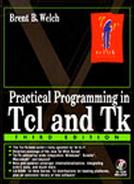When to Use Regular Expressions
Regular expressions can seem overly complex at first. They introduce their own syntax and their own rules, and you may be tempted to use simpler commands like string first, string range, or string match to process your strings. However, often a single regular expression command can replace a sequence of several string commands. Any time you can replace several Tcl commands with one, you get a performance improvement. Furthermore, the regular expression matcher is implemented in optimized C code, so pattern matching is fast.
The regular expression matcher does more than test for a match. It also tells you what part of your input string matches the pattern. This is useful for picking data out of a large input string. In fact, you can capture several pieces of data in just one match by using subexpressions. The regexp Tcl command makes this easy by assigning the matching data to Tcl variables. If you find yourself using string first and string range to pick out data, remember that regexp can do it in one step instead.
The regular expression matcher is structured so that patterns are first compiled into an form that is efficient to match. If you use the same pattern frequently, then the expensive compilation phase is done only once, and all your matching uses the efficient form. These details are completely hidden by the Tcl interface. If you use a pattern twice, Tcl will nearly always be able to retrieve the compiled form of the pattern. As you can see, the regular expression matcher is optimized for lots of heavy-duty string processing.
Avoiding a Common Problem
 | Group your patterns with curly braces. |
One of the stumbling blocks with regular expressions is that they use some of the same special characters as Tcl. Any pattern that contains brackets, dollar signs, or spaces must be quoted when used in a Tcl command. In many cases you can group the regular expression with curly braces, so Tcl pays no attention to it. However, when using Tcl 8.0 (or earlier) you may need Tcl to do backslash substitutions on part of the pattern, and then you need to worry about quoting the special characters in the regular expression.
Advanced regular expressions eliminate this problem because backslash substitution is now done by the regular expression engine. Previously, to get to mean the newline character (or for tab) you had to let Tcl do the substitution. With Tcl 8.1, and inside a regular expression mean newline and tab. In fact, there are now about 20 backslash escapes you can use in patterns. Now more than ever, remember to group your patterns with curly braces to avoid conflicts between Tcl and the regular expression engine.
The patterns in the first sections of this Chapter ignore this problem. The sample expressions in Table 11-7 on page 151 are quoted for use within Tcl scripts. Most are quoted simply by putting the whole pattern in braces, but some are shown without braces for comparison.
